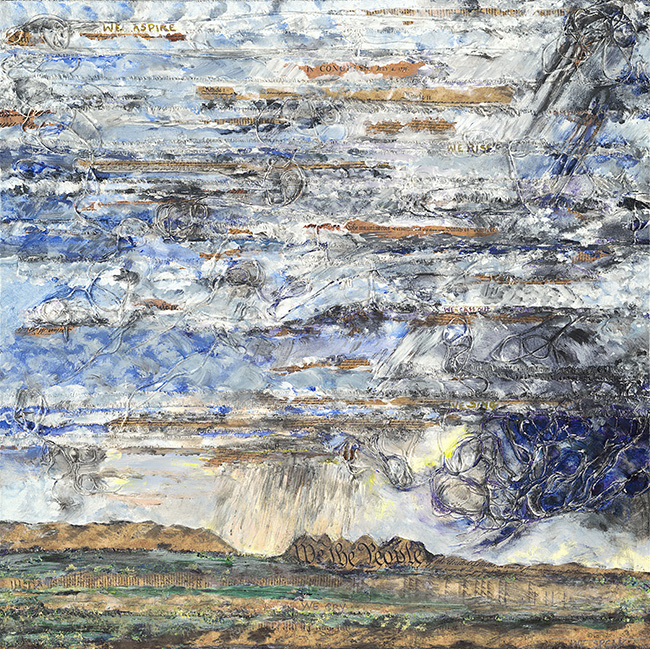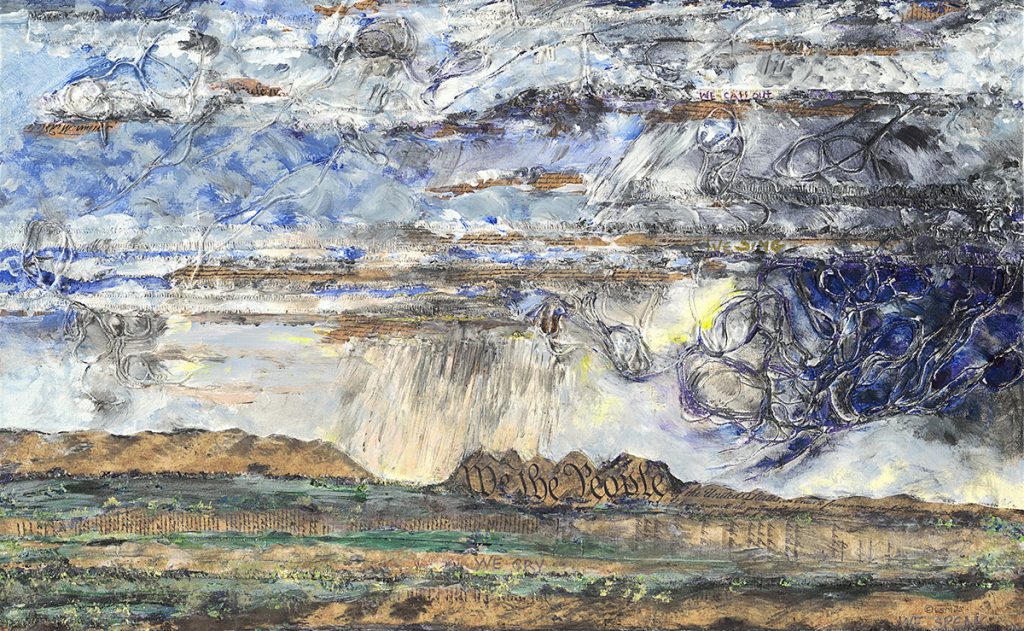L. Scooter Morris, a sensory illusionist, creates paintings that blur the line between surface and substance. She describes her work as “Sculpted Paintings,” a term that captures her method of weaving color, light, and texture into layered experiences. Her art is not about replicating reality but about revealing the invisible truths hidden within it. By folding mixed media into her canvases—whether through surface variations or textured relief—Morris builds works that both demand attention and invite quiet reflection.
At the heart of her practice is a belief that art should start dialogue, especially during moments of societal upheaval. Her paintings become sites of encounter, where beauty is inseparable from meaning. In this way, her art is not only a record of fleeting sensory impressions but also a bridge toward conversations on equality, justice, and the changing fabric of our shared humanity.

The People Speak
Among Morris’s body of work, The People Speak carries a particular weight. It is one of her Sculpted Paintings, but here the sculptural quality is literal and symbolic. The canvas does not exist as a flat surface. Instead, Morris layers canvas on canvas, creating reliefs that almost step forward into the viewer’s space. This technique speaks to depth—of material, of time, and of the ongoing effort required to build a collective identity.
The title is a declaration. The People Speak suggests democracy, the assertion of voice, the insistence that no single authority can silence the chorus of a nation. This is made more poignant by Morris’s decision to weave into the work the founding documents of the United States. By embedding these texts directly into the painting, she forces us to look again at words that are often repeated yet rarely examined. Their placement on canvas implies that they are not static, that they must live, shift, and even fracture if they are to remain relevant.
The texture of the layered canvas embodies struggle. It does not sit comfortably flat, nor does it pretend to resolve itself. Instead, it resists easy reading. In this resistance lies meaning: history is uneven, progress is layered, and freedom is always under construction. The physical build of the painting mirrors the hard work of building a democracy that matches its ideals.
Color plays an equally important role. Morris chooses tones that radiate warmth and resilience. The hues are not meant to soothe but to spark recognition—the recognition that beauty persists even in hardship. The color reminds us of the vitality of spirit, the endurance of people who carry forward the words that define them, even when those words have failed to fully deliver their promise.
Throughout the painting, Morris integrates written words. Some are legible, others obscure, peeking through layers of paint and texture. This choice mimics the way history often reveals itself: uneven, incomplete, contested. Words here are not static text but living entities, rewritten by time and by the people who embody them. The written fragments remind us that identity is not dictated from above; it is spoken and re-spoken by the people themselves.
Taken together—the canvas relief, the embedded documents, the color, the words—The People Speak becomes both a painting and a question. It asks: what does it mean to be “the people”? Whose voices are included, and whose are absent? The work insists that democracy is not an achievement to be checked off but a process, one that must be revisited again and again.
In a cultural moment defined by division, Morris’s work functions as both mirror and map. It mirrors the fractures of history, showing them clearly through its layered, uneven textures. At the same time, it maps a way forward, suggesting that beauty and meaning emerge when we acknowledge struggle rather than erase it.
The People Speak is not meant to be easy. Its layered surfaces refuse a quick glance. Its documents recall both the ideals and the failures of a nation. Its words demand interpretation. Yet within its difficulty lies its gift: it asks us to take part in the act of speaking, to recognize our role not just as viewers of a painting but as participants in an ongoing democratic project.
For Morris, beauty and meaning are never separate. In this work, they are bound together, sculpted into the very fabric of the canvas. The People Speak is both art and statement—an insistence that the people, through struggle, through color, through word, continue to speak.

